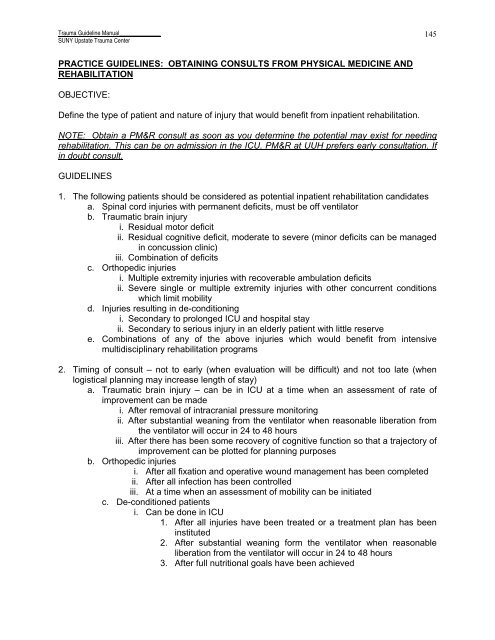Trauma Guideline Manual - SUNY Upstate Medical University
Trauma Guideline Manual - SUNY Upstate Medical University
Trauma Guideline Manual - SUNY Upstate Medical University
Create successful ePaper yourself
Turn your PDF publications into a flip-book with our unique Google optimized e-Paper software.
<strong>Trauma</strong> <strong>Guideline</strong> <strong>Manual</strong>______________<strong>SUNY</strong> <strong>Upstate</strong> <strong>Trauma</strong> Center145PRACTICE GUIDELINES: OBTAINING CONSULTS FROM PHYSICAL MEDICINE ANDREHABILITATIONOBJECTIVE:Define the type of patient and nature of injury that would benefit from inpatient rehabilitation.NOTE: Obtain a PM&R consult as soon as you determine the potential may exist for needingrehabilitation. This can be on admission in the ICU. PM&R at UUH prefers early consultation. Ifin doubt consult.GUIDELINES1. The following patients should be considered as potential inpatient rehabilitation candidatesa. Spinal cord injuries with permanent deficits, must be off ventilatorb. <strong>Trauma</strong>tic brain injuryi. Residual motor deficitii. Residual cognitive deficit, moderate to severe (minor deficits can be managedin concussion clinic)iii. Combination of deficitsc. Orthopedic injuriesi. Multiple extremity injuries with recoverable ambulation deficitsii. Severe single or multiple extremity injuries with other concurrent conditionswhich limit mobilityd. Injuries resulting in de-conditioningi. Secondary to prolonged ICU and hospital stayii. Secondary to serious injury in an elderly patient with little reservee. Combinations of any of the above injuries which would benefit from intensivemultidisciplinary rehabilitation programs2. Timing of consult – not to early (when evaluation will be difficult) and not too late (whenlogistical planning may increase length of stay)a. <strong>Trauma</strong>tic brain injury – can be in ICU at a time when an assessment of rate ofimprovement can be madei. After removal of intracranial pressure monitoringii. After substantial weaning from the ventilator when reasonable liberation fromthe ventilator will occur in 24 to 48 hoursiii. After there has been some recovery of cognitive function so that a trajectory ofimprovement can be plotted for planning purposesb. Orthopedic injuriesi. After all fixation and operative wound management has been completedii. After all infection has been controllediii. At a time when an assessment of mobility can be initiatedc. De-conditioned patientsi. Can be done in ICU1. After all injuries have been treated or a treatment plan has beeninstituted2. After substantial weaning form the ventilator when reasonableliberation from the ventilator will occur in 24 to 48 hours3. After full nutritional goals have been achieved
















